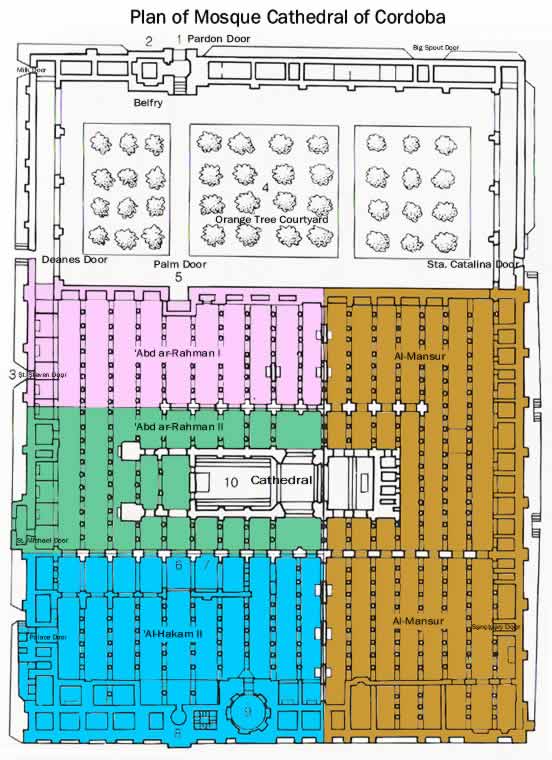The Great Mosque of Cordoba was among the first Universal Heritage Sites declared in Spain in 1984. Experts in Islamic architecture describe it as "the foremost Islamic monument in Spain." (Goodwin, p.55).
The ticket office is located in the Orange Tree Courtyard (Patio de los Naranjos) under the north gallery, to the right of the Pardon Door. Entrance to the Mosque is through the Palm Door.
General Layout of Mosque
The original mosque and the first two expansions make up about two-thirds of the width of the current building's expanse, or 11 naves extending from the west wall (to your right) up to the eastern limit of the cathedral's high altar (to your left) and extend successively southward towards the river to the Mihrab. The eastern third of the building is the last addition, built by Almanzor in 988. The mihrab was left in its once-centered position and the Orange Tree Courtyard was extended to the new width of the building. In the center of the Mosque is the 16th-century Cathedral. Open arches which stood facing the courtyard 800 years ago are now closed, and chapels have been built along the outer walls.

The Original Mosque of Abd Al-Rahman I (786)
is some 13 aisles of columns deep, with the southern limit of cathedral's butresses. Some columns have disappeared into Christian chapel walls and the buttresses. The eastern limit of this section is easy to identify, in line with the high altar and two spaces between columns which were filled in with masonry and decorated with religious art.
Abd Al-Rahman II's expansion (833)
is the most altered by the construction of the cathedral in the 16 th century. It extends a further 9 aisles of columns to the south (3 aisles beyond the cathedral's nave and up to the line of flying buttresses extending to the east.
Al-Hakam II's expansion (964)
and the Mihrab lies beyond the flying buttresses and the northern limit is marked by a nave 5 rows wide and 3 rows deep cleared of columns with raised ceilings, a rose window and Christian tombstones in the floor. This is the 14 th century cathedral. Just to the east is the fabulous Villaviciosa Chapel, followed by 2 enclosed chapels, including the Royal Chapel. At the back of the Mosque, on the south wall, is the richly decorated Mihrab, and to the left, the Cardinal's Chapel, now the Cathedral Museum .
Almanzor's Expansion (987)
is the largest, but most poorly decorated, part of the mosque, extending it 8 aisles to the east and turning it from a rectangular building, deeper than it was wide, into a building with a nearly square floor plan. With its courtyard, the Mosque is 22,250 square meters in area, and it then boasted of about 850 columns (now there is around half that number). (source: Goodwin, p.47)
The Cathedral
was begun in 1523 and built during the remainder of the 16 th century, with Gothic structure, Renaissance vaulting and domes, and baroque choir stalls and pulpits (1750). Columns and the original roof were removed in the central area (mostly from Al-Hakam II's expansion) to make way for the new transept and its structural supports.
See Also: Photo album of Mosque Interior (98 photos) | Photo Album Mosque Exterior (20 Photos)
Sources: [Goodwin pp.44-55, Orti Belmonte pp.15-35, Makariou pp.68-73]
about us | disclaimer ©2005-2014 Tony Reed


